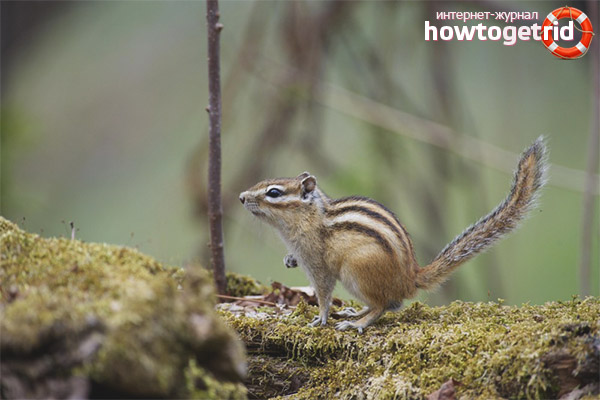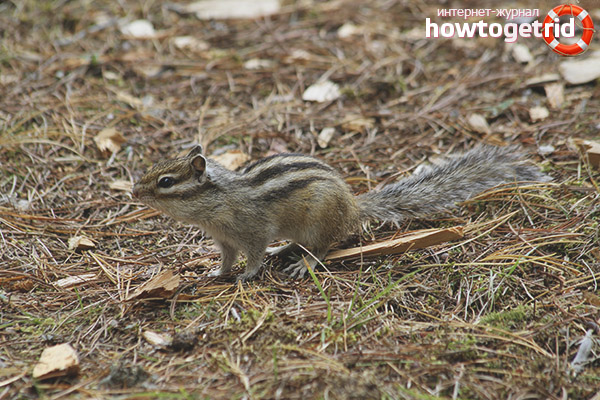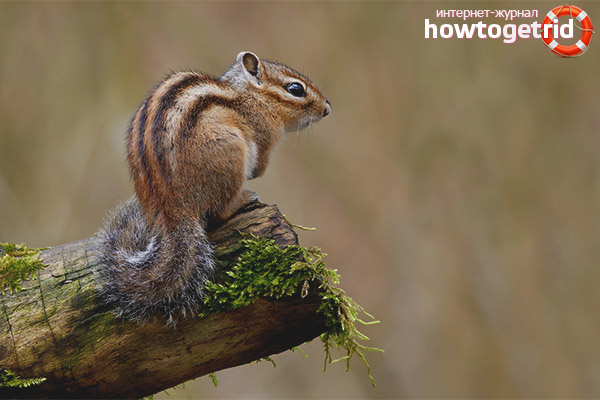The content of the article
For the most part, representatives of the squirrel family of the chipmunks genus live in North America, and only Asian chipmunks inhabit Eurasian open spaces. That is why zoologists often attribute these animals to a separate genus, because in connection with a special habitat and, as a result, slightly different development conditions, they could acquire quite unique features. Nevertheless, according to the description, they completely coincide with the other rodents, although they can stand out in some way.
Main description
The body of this animal is quite compact and is less than 30 centimeters, while the tail can be from 7 to 12 centimeters, and the body itself can be about 15. Its weight is up to one hundred grams, and this weight allows them to be quite mobile.
In general, if we compare the Asian chipmunks and squirrels (after all, the chipmunks belong to the squirrel squad, so this comparison looks quite adequate), then the former are faster and more mobile. Although it is difficult for anyone who saw the squirrel to imagine how rodents can be faster and more active than these moving tree dwellers. However, the Asian chipmunk runs fast thanks to the longer forelegs compared to the hind legs.
In addition, the actual body of these chipmunks is more slender, and this fact also adds mobility. It is quite easy to recognize the animal by its characteristic “shape”, which consists of the general body color in ocher tones, which is combined with five dark stripes located on the back.
Habitat
For the most part, Asian chipmunks occupy the forests of the taiga zone. They are located throughout the taiga - from the European part of the country to the Far East. Some even find themselves in Kamchatka, although in small numbers.
Understanding where the chipmunks settle is pretty easy on plants. It is necessary to focus on cedar pine and elfin.
Lifestyle
Based on the foregoing, it is easy to understand food preferences. Chipmunks prefer to feast on seeds from pine nuts. In the absence of those, they are happy to eat any other nuts.
Chipmunks are omnivorous, that is, they can eat both plant and animal food. In many ways, nutrition is determined by seasonality. They prefer green shoots during the growing season, and can also collect roots.
From animal food they do not disdain mollusks, spiders and insects. Of the plant, it should be noted such preferred options as:
- seeds of Korean and Siberian cedar;
- rowan, linden, maple seeds;
- seeds of umbrella and herbaceous plants;
- wheat
- oats;
- buckwheat.
Sometimes they pick and eat mushrooms.
The period of cold weather is caused by the chipmunks falling into hibernation, they reduce their own body temperature and slow down metabolism. As a result, the chipmunk sleeping, thus, takes only a couple of breaths per minute at a body temperature that is less than about 6 degrees above normal, but sometimes they wake up, wander half-asleep to their own pantry, eat some goodies from stocks made and go to bed again until the next time you want to eat.
Asian chipmunks are great drives and incredibly farm animals. Firstly, they can keep some food with them, as they have surprisingly developed cheek pouches.In addition, they collect about 5 kilograms (a significant amount with a weight of about a hundred grams) of various provisions for the winter, this includes panicles of cereals and all kinds of seeds with nuts.
Of course, such thrifty is quite justified, since even squirrel relatives often ruin the underground pantries, where the chipmunks so carefully put their provisions. Often sables, wild boars or bears can catch their eyes on these warehouses.
However, the chipmunks themselves also quite normally adapted to such conditions and it is not so easy to understand where they built their mink. When an Asian chipmunk digs an underground shelter, he prudently takes the earth away from his mink, that is, it is not entirely clear where these digs are from these “clues”. Also, the holes have a solid structure and it is difficult to navigate there (if you yourself are not the chipmunk who made this hole) in various moves and find something useful for yourself.
Chipmunks are individualists, each of them has its own plot and its own mink, and they do not get along in one hole. Even if they are sitting in the same cage, they begin to constantly fight among themselves.
Nora is somewhat similar to pretty good apartments, which include:
- lined with down and hay;
- separate bedroom;
- pantries;
- the restroom.
However, they are able to leave such comfort. If the feed site becomes ineffective, they are moved to a new one.
Separately, it should be noted the sound alarm system, which is quite developed and diverse. For example, in times of danger, the chipmunk begins to make a trill or whistle. Females in the mating season make characteristic sounds.
Breeding Asian Chipmunks
If circumstances are optimized, then the female finds a partner who is guided by the characteristic sounds that zoologists describe as a “hook-hook”, although, of course, it is quite difficult to convey the phonetic content of this mating chipmunition in a letter. One way or another, the spring mating season ends with the birth of babies in the second half of May. The duration of pregnancy does not exceed four weeks, and the number of small chipmunks is no more than 10, and the minimum is from 3 animals.
Newborns are almost completely asexual and weigh no more than 4 grams. They are naked and blind, but after a couple of days they begin to acquire wool with characteristic stripes on the back. The eyes open after four weeks, and in total they remain in the maternal mink for about 8 weeks. By the end of summer - the beginning of autumn, chipmunks set off for "free swimming" and leave their parental home. Therefore, the autumn population is characterized by a significant increase in young growth.
In captivity, the Asian chipmunk is able to live up to 10 years, but in the wild, the average age of residence is 3-4 years.
Interesting Chipmunks Facts
- The inhabitants of Siberia, who listened to the chipmunks, for some reason considered these animals shouting something like "chipunkun" (as mentioned earlier, the chipmunks sound system is quite developed), and from here, in fact, the name went - chipmunk, which is the onomatopoeic name of the animal.
- In the mouth of an Asian chipmunk, up to 80 grams of nuts can be located. That is, they quite easily carry with them provisions equal to their own weight.
The commercial value of these animals is relatively small.
Number situation
- Nizhny Novgorod region;
- Tatarstan
- Republic of Chuvashia.
It is these areas that represent the western boundary of the habitat. Therefore, in these areas, the number of chipmunks is limited. Accordingly, there is a need to take care of the population.
Nevertheless, in other regions, fishing for the Asian chipmunk is quite affordable and many are engaged in fishing there, in particular, the fur of this animal is used, which can be quite useful. Sometimes fishing for an Asian chipmunk is of prophylactic importance, since these animals can cause significant damage to various garden and grain crops, as well as spread various diseases. This is possible where the population reaches a significant size, in the eastern parts of the range.
Video: Chipmunks (Tamias sibiricus)












Submit